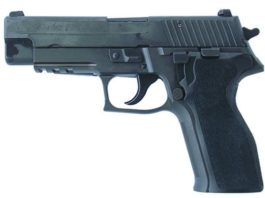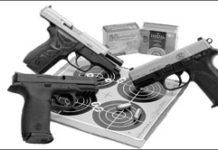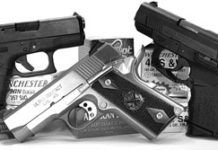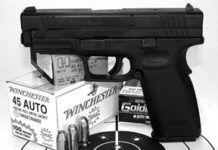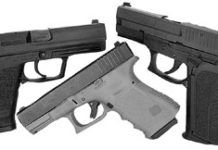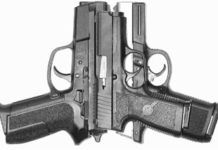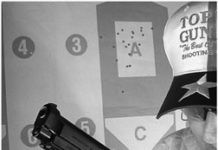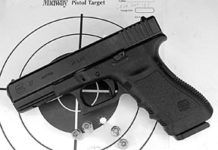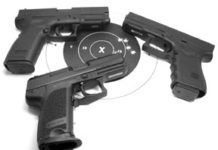.40 S&W Concealables: M&P40 Edges Out Sigarms P229 SAS
Subcompact Power: .45 ACP, .40 S&W, and .357 SIG Guns
Recently we received a letter from a subscriber who asked us to compare a small .45 ACP 1911 pistol to some of today's more popular options in the category of subcompact pistols. Keynotes of comparison were action design, similar size, and similar stopping power. Also, our reader wanted us to compare the speed and integrity of fundamental controls other than the trigger. A concealed-carry gun may never be reloaded during a confrontation, but you wouldn't want to drop the magazine by accident or fumble releasing the slide.
Your competition or hunting gun may be the love of your life but a powerful subcompact pistol is the one you are likely to spend the most time with. In this test we'll get up close and personal with three pistols small enough to blend in with your lifestyle and powerful enough to preserve it. The Springfield Armory Ultra Compact 1911A1 PX9161L, $952, represents the traditional .45 ACP single-action single-stack pistol. The Glock polymer pistol is another very popular option. The Glock 33 No. PI3350201, $599, is chambered for .357 SIG, which offers .357 Magnum power in a controllable high-capacity platform. Smith & Wesson's SW990L in .40 S&W is also a polymer pistol with a double-column magazine, but distinguishes itself from the Glock pistol by utilizing a Walther design. Our SW990L No. 120233, $729, like the others, employed approximately a 3.5-inch barrel, and all three were specifically designed for concealed carry.
New Semi-Auto Power Pistols: Springfields XD 45 Is A Winner
Two recent pistol introductions have been much-ballyhooed in the gun press and firearms industry: Springfield's XD 45 and the Smith & Wesson M&P 40. At the NRA annual meetings in Milwaukee May 19-21, the new XD pistol in .45 ACP won Handgun of the Year notice from NRA's American Rifleman magazine, and it won Handgun of the Year at the Shooting Industry Academy of Excellence awards. The S&W M&P .40 was likewise nominated for the Shooting Industry award, and another NRA publication, Shooting Illustrated, named the M&P as its 2006 Handgun of the Year.
Because interest seems high, we wanted to weigh in on which pistol we thought was the best, so we acquired a $559 Springfield Armory XD (Extreme Duty), and a $624 Smith & Wesson M&P (Military and Police) pistol. Of course, both were designed to provide an effective weapon for law enforcement and military use, but they certainly will serve as personal defense guns for civilians that are durable, easy to maintain and within most budgets.
The XD is based on the Croatian police sidearm that Springfield Armory has adapted to the American market. Chambering the XD for .45 ACP is the latest volley aimed at landing the XD in the holster of every policeman. The XD is a proven design, but we wondered how the power and size of .45 ACP ammunition would affect the integrity of the machine as well as the friendly ergonomics that have attracted so many buyers in other chamberings. The Smith & Wesson M&P 40 S&W is the result of research and development that included consultation with the law enforcement and military training community. Starting with a clean slate, Smith & Wesson has risked much more than Springfield Armory by having to spend money on tooling up. Was it worth the investment?
.40 S&W Polymer Pistols: The Glock M23 Is A Proven Winner
Most shooters don't get too worked up about new polymer-framed auto pistols; they don't have the charm of a well-built 1911 .45 ACP or the character of an old Chiefs Special .38. Instead, what plastic guns do well is protect their owners, and in this defensive role, they excel. If you doubt this statement, simply check out what gun is riding on the hip of today's law-enforcement personnel. More often than not, it will be a polymer-framed high-cap 9mm or .40 S&W, and quite often, it will be a Glock.
Glock introduced the first successful plastic-framed pistol more than twenty years ago, and it is still the most popular polymer by a large margin. But several other manufacturers make comparable polymer pistols, and we recently tested two of such guns against the mainstay .40 S&W Glock Model 23.
Our first test product was the Heckler & Koch USP 40 Variant 9 .40 S&W USPLEM, $769. This design adds a manual thumb safety to the hinged-trigger USP pistol. Sigarms's latest polymer pistol, the SP2022 .40 S&W (No. E2022-40-BSS, $715), offers a decocker. Our Glock 23 .40 S&W No. HXL616 cost $670. All three guns came with night sights, and barrel length was approximately 4 inches.
In these guns we shot Winchester's 155-grain JHP Ranger loads, 180-grain hollowpoints from Black Hills Ammunition, and 165-grain FMJ rounds loaded to USPSA major caliber specifications by Georgia Arms (770-459-5117). This meant these rounds were expected to travel at an average velocity of at least 1000 fps from a 5-inch barrel.
For the testing, our shooters visited the comfortable confines of Top Gun of Texas (www.topgunrange.com), where we took advantage of the opportunity to adjust lighting conditions to test the effectiveness of each gun's night sights. Using the Black Hills rounds exclusively in this portion of our tests, we fired standing unsupported from a distance of 7 yards. We adjusted backlighting to provide just enough illumination to allow us to see a 3-inch circle on a Hoffners ABC16 target (www.hoffners.com). We recorded the first 10-round group we shot. Accuracy data from the bench was recorded at 15 yards, and we fired single action only from the Sigarms and HK pistols.
Our first question was whether or not the Glock SafeAction trigger, a full-time double-action system, would put the Model 23 gun at a disadvantage. Second, we asked if the addition of an active safety on the Heckler & Koch pistol or, the decocker on the Sigarms SP2022, added safety, or did these mechanisms hinder operation. Though we formed definite likes and dislikes about each gun, we found that they all ran trouble free with a variety of ammunition. Otherwise, let's get a detailed look at how well they shot in the text below:
.40 S&W Quick-Action Polymer Pistols: Pass On These Two
Walther America's P99QA and the Smith & Wesson SW99OL offer plenty of extras, but the Walther's trigger function and the lack of a safety on the S&W gun trigger a pair of Don't Buys.
.40s From Kahr, Sigarms, S&W: Should You Pick DA-SA or DAO?
Kahr's P40 shot fast, and Sig's new Sig Pro 2340 worked, but Smith & Wesson's SW40SV required a strong trigger finger.
TDA .40 S&W Pistols: Vertec Beats Cougar and 4013TSW
You can't go wrong with the sexy Italian $875 Beretta Cougar Inox or the all-American $940 S&W 4013TSW. But our first pick is the slightly larger $758 Beretta 96 Vertec.
Tiny and Not-so Tiny Forties: Kahrs PM40 Is Our Carry Pick
For self-defense, we liked the PM40 better than the heavier, bulkier Springfield Sub-Compact XD and CZ's new Rami.
Lightweight Carry Options: A 9mm, a .40 S&W, and a .45 GAP
Glock's new $640 Model 37 excels with a brand-new round. Smith & Wesson's titanium $812 4040PD opens new doors, but the $550 FN P9 comes up short.
Subcompact .40 S&Ws: Glock 27 Versus Taurus Millennium Pro
Last month we tested two subcompact 9mm pistols that, based on the shared technology of polymer construction and striker-fired actions, were set to compete with the Glock Model 26. This month we take a look at Taurus's .40 S&W Millennium Pro 140SSP, matching it against Glock's subcompact, the GL27. The GL 27 and the Taurus pistols are almost identical to the 9mm handguns we tested previously, and we were particularly interested in how the .40s would stand up against the abuse the stouter S&W round delivers.
In the past, high-cap polymer 9mm semi-auto designs and frames rechambered for.40 S&W have not always shouldered the extra energy load too well. Structural failures sent many manufacturers back to the drawing board. Problems in polymer and steel-framed guns alike included cracked frames and slides and jumbled internal mechanisms.
Besides questions about durability, we also wanted to explore the operational differences between these two pistols. Would shooters be able to use the same techniques to ensure fast, accurate hits, or would the guns be so different that we would be forced to shoot them differently?
Here's what we found when we tested the Glock 27, $641; and the Taurus PT140 Millennium Pro 140SSP, $485, side by side:
Alloy-Framed .40 S&W Compacts: We Pit SIGArms against Beretta
Looking through the pages of the many different gun magazines, any shooter might be dizzied by the advertisements alone. New models seem to appear with every issue, while simple updates in the finish or style of an old design are trumpeted as well. In this test we will try out two pistols that get less than their share of press, the $620 SIGArms P239 and the $702 Beretta Mini Cougar 8040, both chambered for the stout .40 S&W round.
The P239, first issued in 9mm, has since been successfully chambered in much more powerful calibers such as the .357 SIG (see Gun Tests, August 2001) and the .40 S&W. The P239 is unusual among the SIGArms lineup. The P239 is one of few pistols in the Sigarms lineup that feed from a single-column magazine. Like the Beretta pistol in this test, most of the SIGArms pistols use a higher-capacity double-column magazine that results in a much wider and rounder profile at the grip. In terms of compact design we think of the P239 as a TDA variation of Colt's Officer's .45 ACP model. Both pistols share the advantages of being flat and easy to conceal while offering a natural point to the shooter's hand.
Compared to the SIGArms P239, the Beretta 8040 Mini Cougar is a more sophisticated weapon. The decocker lever (found on both sides of the pistol) can also disconnect the trigger, rendering the gun completely safe. Hammer-back safety on, or cocked-and-locked carry is not an option, however.
We learned a lot more about these two pistols when we loaded magazines and went to the range. Here's what we found out.
Compact Polymer .40 S&Ws: Glock, Springfield, and H&K
While older designs, such as the double-action revolver and the 1911 semi-automatic pistol, continue to prosper through new materials and manufacturing techniques, the polymer-framed pistol may be at the forefront of pistol development. The .40 S&W is the leading round chosen by today's local and federal law-enforcement professionals. Compact .40s (3.5- to 4.25-inch barrels) bridge the gap between plainclothes duty and civilian concealed carry, and of these, the lightweight "plastic" pistols lead the way. And the Glock line of pistols is perhaps synonymous with the word "polymer."


























